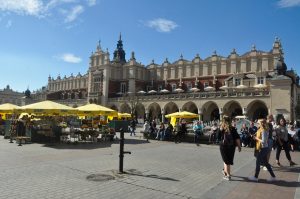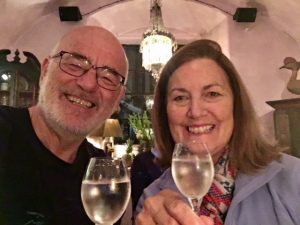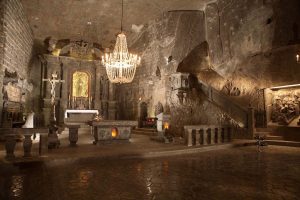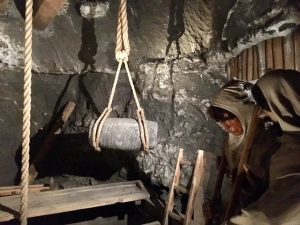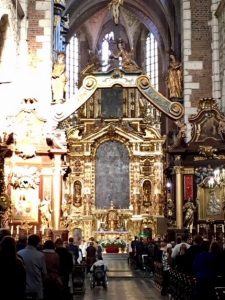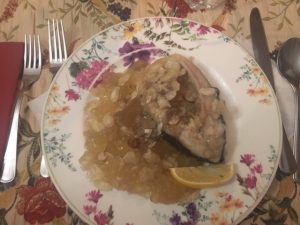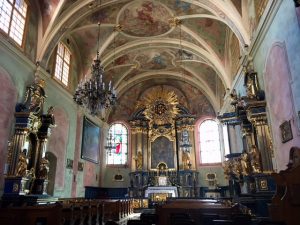Having arrived at the airport in Krakow, we had to wait for the incoming flight from Birmingham, bringing four new group members to join us, replacing the four travelling home.
I had arranged for transport to take us all into town and the Kossak Hotel. It was a bright, sunny and warm morning. Predictably, the hotel had not prepared our rooms so we headed off to the magnificent square in the centre of town for an early lunch. At 200 x 200 square metres it is the largest medieval square in Europe. It really is beautiful, with elegant buildings all around it. In front of the majority were umbrellas and tables bringing the restaurants out into the square. In the centre, almost dissecting the square in half is the Cloth Hall, now a multitude of colourful stalls focusing mainly on souvenirs and jewellery.
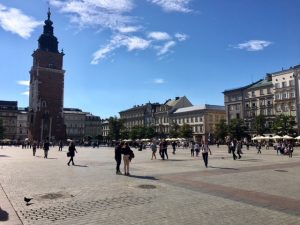 Standing alone towards one end of the Cloth Hall is the Wieza Ratuszowa, the Town Hall Tower. You had the feeling that this was just part of a once much bigger building but there was no evidence of that. On the other side of the Cloth Hall in the opposite corner, set at an angle, thus breaking up the symmetry of the square, is St Mary’s Church, brick built and standing tall with its two differently crowned towers. On the hour, every hour, a bugler blows his horn from windows at the very top of the left hand tower, re-enacting the tradition of an ancient Krakow Legend.
Standing alone towards one end of the Cloth Hall is the Wieza Ratuszowa, the Town Hall Tower. You had the feeling that this was just part of a once much bigger building but there was no evidence of that. On the other side of the Cloth Hall in the opposite corner, set at an angle, thus breaking up the symmetry of the square, is St Mary’s Church, brick built and standing tall with its two differently crowned towers. On the hour, every hour, a bugler blows his horn from windows at the very top of the left hand tower, re-enacting the tradition of an ancient Krakow Legend.
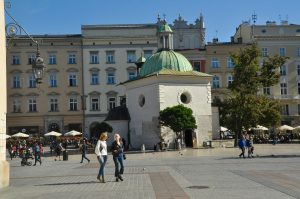 There was too much to see and take in in one go, but we did make time to visit the small church of St Adalbert’s, standing alone in one corner, at an angle, breaking up the symmetry of the buildings around the perimeter. The reason why it stands out is that it was built in the 11thC, which means it pre-dates the square. It is a mix of pre-Roman, Roman, Gothic, Renaissance and Baroque architecture. As soon as you walk in you can tell it is old. You drop down two metres as the floor level is that much lower than the rest of the square.
There was too much to see and take in in one go, but we did make time to visit the small church of St Adalbert’s, standing alone in one corner, at an angle, breaking up the symmetry of the buildings around the perimeter. The reason why it stands out is that it was built in the 11thC, which means it pre-dates the square. It is a mix of pre-Roman, Roman, Gothic, Renaissance and Baroque architecture. As soon as you walk in you can tell it is old. You drop down two metres as the floor level is that much lower than the rest of the square.
Back at the hotel we enjoyed watching the light fade over the city from the rooftop terrace bar while enjoying a drink or two. The low sunlight on the castle was particularly good, highlighting all its features.
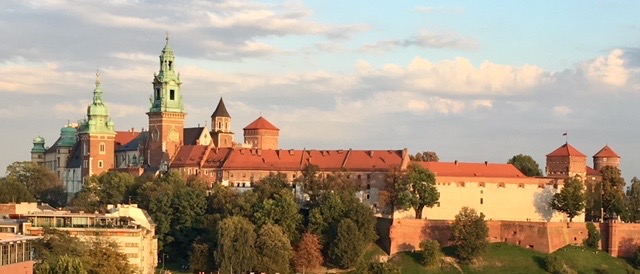 While some went out in search of an evening meal a few of us donned down jackets and braved the falling temperatures on the roof to enjoy a particularly good meal and a couple of bottles of red wine. We were at least warm on the inside even if the outside was a little chilled. After the early start of the morning, an early night was needed so we retired to our rooms.
While some went out in search of an evening meal a few of us donned down jackets and braved the falling temperatures on the roof to enjoy a particularly good meal and a couple of bottles of red wine. We were at least warm on the inside even if the outside was a little chilled. After the early start of the morning, an early night was needed so we retired to our rooms.
The following morning the majority of us went on an organised tour of Auschwitz and Birkenau. Because it was a comprehensive and chilling experience, I would prefer writing about it in a separate post.
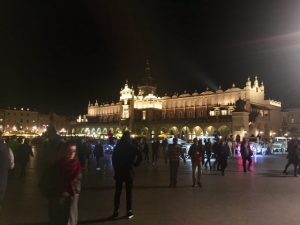 By the time we returned to the hotel in the late afternoon, we were all pretty tired, both physically and mentally. After a suitable chill out time, Angela and I drifted towards the square in search of somewhere to eat. We didn’t really want to eat on the square again, but explore some of the narrow back streets of the old town. These are full of tucked away little bars and bistros full of Krakovians and tourists alike. The atmosphere was buzzing.
By the time we returned to the hotel in the late afternoon, we were all pretty tired, both physically and mentally. After a suitable chill out time, Angela and I drifted towards the square in search of somewhere to eat. We didn’t really want to eat on the square again, but explore some of the narrow back streets of the old town. These are full of tucked away little bars and bistros full of Krakovians and tourists alike. The atmosphere was buzzing.
After much deliberation, umming and ahhhing, we finally took the plunge and entered the narrow door of Cafe Camelot. It was quite busy but not overflowing. We were directed to the smallest table where two people could possibly eat but it turned out not to be a problem. Our table was in the middle of the room and we were largely surrounded by smart young locals. While we made up our minds what to eat we sampled a vodka each – very enjoyable. This was quickly followed by a delicious meal and a glass of wine or two. Service was good, atmosphere and ambience were good; the artwork on the walls and in the niches provided extra inspiration for conversation. Unfortunately we did not time our visit with live music, otherwise we might have had reason to spend much longer there.
Sunday dawned bright and sunny. A shame really as we were going to spend quite some time underground at the Wieliczka Salt Mines. Salt was first mined here in the 13thC and continued well into the 20thC. The economy of Krakow and the whole of Lesser Poland depended heavily on the income it generated. In 1978 it was designated a UNESCO World Heritage Site.
I was really looking forward to visiting the mines as the pictures I had seen were impressive and exciting. Unfortunately, it did not live up to expectation. There were impressive highlights but these were punctuated by long periods where there was not a lot to see. It did not help that we were kept waiting for at least half an hour before we were allowed to enter. I suspect that they stagger entry so that there is a staggered progress throughout the mine tour. At the beginning of the day it is inevitable that you are probably going to have to wait longer.
Once we were in, the descent into the mine was impressive; no cage lowering us into the depths, but a wooden staircase. Looking down over the handrail from near the top, we could not see the bottom. It seemed to go on forever. Going down, constantly turning left down the flights of stairs made you feel quite giddy at times. Eventually, we reached the point where we left the stairs to enter a tunnel. This was lined with interlocking tree trunks that supported both the walls and the ceilings. The amount of timber we saw underground during the tour was phenomenal, but then Poland has a lot of woodland. Much of the tour was spent walking along many of these tunnels with not a lot of visual interest. Our guide was talking into a microphone and we were listening with a headset. In the confines of tunnels it meant that unless you were standing close to her it was difficult to see what she was talking about.
When we did enter the many caverns they were quite dull. The rock is grey and fairly featureless, unlike a natural cave that has been forming over millions of years.
Despite my negative thoughts about the mine there can be no doubting the incredible endeavour of the hundreds of men who worked in it. It was only towards the end of its life as a working mine that machinery was available and used. For much of its existence the only way the salt could be extracted was entirely by manpower.
After two and a half hours underground, we emerged into the warm sunshine and eventually headed back into Krakow, where we had free time until our departure late the next day.
Taking a long late lunch in the square in warm sunshine, we pondered what to do next. I had initially been interested in taking a horse and carriage tour around the city but having looked into it, it was very expensive and also there was no commentary. It was a means to be seen rather than a means to see. Instead, Angela and I took a tuk-tuk tour of the Old Town and the Jewish Quarter of Kazimierz. Our driver, Paul, had his iPhone connected to a speaker and, every so often, taking his eyes off the road, he programmed it to give us snippets of information about particular buildings. It was a relaxed tour and we could get off wherever and whenever we wanted to venture inside the buildings.
It was refreshing to see a city where there was no jostling for position on the roads. Everybody seemed to be very civil to each other, giving way at junctions, allowing pedestrians to cross without the fear of being knocked down. Within the Old Town, traffic moved very sedately, which made a pleasant change.
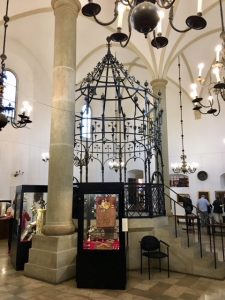 Kazimierz was distinctive with its narrow cobbled streets, monasteries, synagogues, and old shop frontages from a bygone age. Funky restaurants and cafes now occupy those old, traditional shop fronts. It was here, outside the 600 year old Synagoga Stara, that we met Claire, who had borrowed a bicycle from the hotel and was taking herself on a tour of the city. That just highlights how safe the roads were.
Kazimierz was distinctive with its narrow cobbled streets, monasteries, synagogues, and old shop frontages from a bygone age. Funky restaurants and cafes now occupy those old, traditional shop fronts. It was here, outside the 600 year old Synagoga Stara, that we met Claire, who had borrowed a bicycle from the hotel and was taking herself on a tour of the city. That just highlights how safe the roads were.
The Synagog Stara is no longer a functioning synagogue but a museum telling the story of everyday Jewish life.
In the evening we all ventured back to Kazimierz for our last night meal together at Klezmer Hois. This is a Jewish, but not full kosher, restaurant in the building that used to house the ritual bath. The restaurant is furnished like a bourgeois dining room from the early 20thC with old, dark furniture and embroidered tablecloths.
I made an interesting choice from the menu, particularly the starter. I chose Carp, Jewish Style. First of all, I had to get my head around the fact that I was eating, what I considered to be, an ornamental fish rather than a traditional fish for the table. It was a dense meat with an organic, earthy flavour to it. What I struggled more with was the plateful of jelly that it was sitting on. It was absolutely swimming in a jelly not dissimilar to that you get with pork pies. At least with pork pies it is only a small amount; my whole plate was covered in the stuff and I had to leave most of it. The roasted goose leg I had for my main was much better.
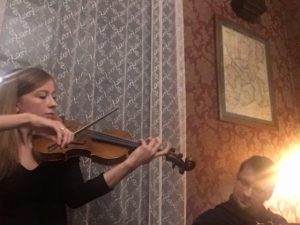 However, the highlight of the evening was not the food but the concert that took place just over my right shoulder. A trio of young people, a double base player, an accordionist and a violinist played two sets while we ate. They were superb and the girl playing the violin knew how to make her instrument sing. I realised, watching her, why I never got the same effect when I played the violin as a child. I didn’t move my body in rhythm with the music. I stood stock still in a state of intense concentration. She was so relaxed it was beautiful to both watch and listen.
However, the highlight of the evening was not the food but the concert that took place just over my right shoulder. A trio of young people, a double base player, an accordionist and a violinist played two sets while we ate. They were superb and the girl playing the violin knew how to make her instrument sing. I realised, watching her, why I never got the same effect when I played the violin as a child. I didn’t move my body in rhythm with the music. I stood stock still in a state of intense concentration. She was so relaxed it was beautiful to both watch and listen.
Our last day in Krakow, we decided to explore on foot. We wanted to look at some of the churches and also to visit the cathedral within the castle. We visited numerous churches. I am never sure whether photographs are allowable. They are certainly not allowed in the most spectacular of church interiors, St. Mary’s on the edge of the square. It is magnificent. The altars in all of the churches are huge, and numerous, extremely ornate and mesmerising. The detail in them is astonishing. I am not used to such ornate and elaborate centre pieces and I found myself sitting and looking at them for long spells.
Choosing to have our last lunch in Krakow on the square, yet again, we chose a front row table looking out on to the area where the horse and carriages park, touting for business. I found this a fascinating spectacle. Each pair or ornately decorated horses and gleaming white carriage is cared for by a very smartly outfitted, often very attractive, woman. While parked in line, they talk to passers by trying to lure them into their carriage for what is actually quite an expensive ride. Obviously, the more people you can get into a carriage the more cost effective it becomes.
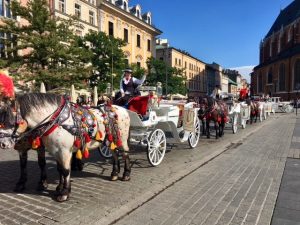 I was fascinated by their technique. As soon as clients had taken the bait and climbed aboard, a less attractive, often scruffily dressed, male jumped up next to the girl and took over the reigns. This did not happen every time but most times. There seemed to be no communication between the driver(s) and the clients; it was simply a ride around the streets. I would want more for my money. I know our tuk-tuk tour was not as glamorous but we did talk to our driver, we did have a commentary and we were able to get out to visit places of interest.
I was fascinated by their technique. As soon as clients had taken the bait and climbed aboard, a less attractive, often scruffily dressed, male jumped up next to the girl and took over the reigns. This did not happen every time but most times. There seemed to be no communication between the driver(s) and the clients; it was simply a ride around the streets. I would want more for my money. I know our tuk-tuk tour was not as glamorous but we did talk to our driver, we did have a commentary and we were able to get out to visit places of interest.
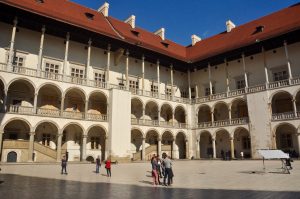 In the afternoon we walked around the Planty, a green area that surrounds the old town where the medieval walls once stood. This led us to Wawel and the ramp which leads up to the castle with a huge variety of architectural styles, as additions and alterations had been made with each incumbent king. The highlight for me was the courtyard, a Renaissance style building designed and built by artists from Florence. It was full of grace, elegance and style; such a pleasure to gaze upon.
In the afternoon we walked around the Planty, a green area that surrounds the old town where the medieval walls once stood. This led us to Wawel and the ramp which leads up to the castle with a huge variety of architectural styles, as additions and alterations had been made with each incumbent king. The highlight for me was the courtyard, a Renaissance style building designed and built by artists from Florence. It was full of grace, elegance and style; such a pleasure to gaze upon.
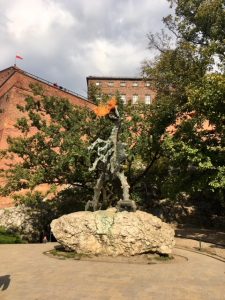 Leaving the castle we dropped down to the river just in time to catch the dragon breathing fire. This metal statue, standing at the mouth to its cave, celebrates the legend associated with it. Legend has it that a dragon livIng in the cave devoured the town’s virgins until it was outwitted by a clever trick. The story is probably based around the fact that pre-historic animal bones were found in the cave.
Leaving the castle we dropped down to the river just in time to catch the dragon breathing fire. This metal statue, standing at the mouth to its cave, celebrates the legend associated with it. Legend has it that a dragon livIng in the cave devoured the town’s virgins until it was outwitted by a clever trick. The story is probably based around the fact that pre-historic animal bones were found in the cave.
That was it. No more time to enjoy Krakow. It is a beautiful city with so much to offer. We had been there for four days and I think, with the exception of Auschwitz and the salt mines, we had really only scratched the surface. There is plenty still to see and we could look at some of the places we visited in greater detail. Sometimes, a long weekend in a city is long enough. Not Krakow. I would happily return for another long weekend of exploration.

